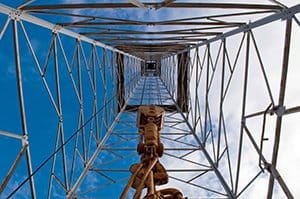
BJM Slurry Pumps Recirculate and Reuse Drilling Mud in Texas
We present another manufacturer whose products we distribute—and this time in action: BJM Pumps of Old Saybrook, CT. Since 1983, it has created two main types of pumps, submersible pumps and electric motor testers, which, as we shall see, have gained esteem for their quality and function. Cortech distributes several types of its pumps, for various functions: solids handling, high temperature, dewatering, and sand, sludge, and slurry. This latter kind of pump, the KZN series, is also designed for driller’s mud, as a case study from West Texas Premix Pits (WTPP) in Midland, TX recently demonstrated.
West Texas Premix Pits serves gas-drilling clients in the Odessa-Midland area of Texas. Oil and gas drilling, as the study describes, requires the use of fluid, called ‘mud’ or ‘driller’s mud.’ The fluid may be freshwater, saltwater (brine), oil, or some kind of synthetic liquid. The choice of mud depends on the kind of rock drilled, the cost of the operation, and the projected environmental impact, amongst other things. The mud serves a number of purposes during the drilling process: it lubricates and cools the drill; it brings the rock fragments, called ‘cuttings,’ to the surface (the solids are borne up suspended in the liquid); it prevents the wellbore from collapsing inward (via the pressure that the liquid exerts on the inner surface of the wellbore); and it stops the oil or gas from entering the wellbore before intended (again by occupying the space and because the ‘mud’ will be of a composition chosen so that it does not mix with the oil or gas in the rock). WTPP, like many such firms, reuses its drilling mud, but to return it to a useful state, the cuttings must be filtered out—or, rather, the liquid must be removed from around the cuttings, so to speak.
This step is rather simple yet requires proper tools, and this is where the KZN series of BJM Pumps enters the process. After use in the wellbore, and still laden with the cuttings extracted from it, the mud is transported (pumped) to a reserve pit, where it is allowed to stand so that the cuttings settle out of the liquid. For the pump that extracts the clean liquid from the reserve pit, WTPP chose a BJM product. Why? WTPP created a way to float its pumps on the surface of the reserve pit: the few inches of contact, rather than complete submersion, facilitates the extraction of a cleaner liquid, and a BJM pump did the job, even within the limited scope of operation. Initially WTPP rented the BJM pumps, but afterward they were so satisfied with the products, they bought their own.
The KZN series of the BJM Pumps, effective for the special operation of West Texas Premix Pits, is just one of the expertly-engineered products that Cortech is proud to distribute. Whatever your pumping needs here in Southern California and Nevada, including oil and gas drilling, Cortech can connect you with the best products.
For more details, read the entire case study.
- Burlingame Engineers
- Cortech Engineering
- Turbo Machinery
- Turbo Machinery
- Burlingame Engineers
- Cortech Engineering
